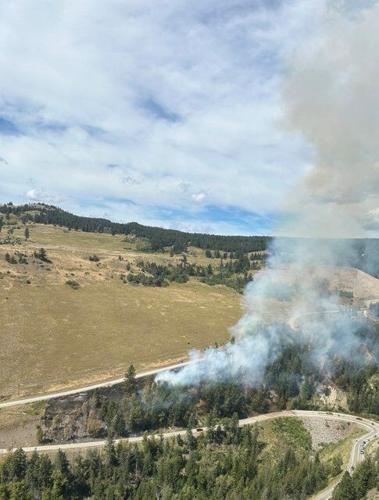Hundreds of residents who were forced out by a wildfire burning along Cameron Lake on Vancouver Island have been allowed to return home Monday.
The Regional District of Nanaimo posted an update removing 257 properties from its evacuation order due to the Wesley Ridge blaze, although they remain subject to an alert, with residents told they must be ready to leave right away.
The BC Wildfire Service changed the classification of the blaze on Monday to "being held," and said it wasn't expected to grow beyond existing containment lines.
Douglas Holmes, director of the regional district's emergency operations centre, said it was a "terrific day" as most people were allowed to return home.
However, 37 properties in Little Qualicum River Village remain evacuated.
Holmes told a news conference Monday that decisions about evacuation orders are based on a combination of factors, including fire behaviour, the availability of water to douse any flare ups, as well as the condition of roads in the area.
"We're working very, very hard to get those last properties that are on evacuation order, to get them back to their homes as soon as possible," he said.
The six-square kilometre fire is burning about 60 kilometres northwest of Nanaimo.
Madison Dahl, a fire information officer with the wildfire service, said "a lot of work" had gone into fighting the fire to reach the point where it could be reclassified.
The decision was based on the conditions of fuels, the weather forecast and the availability of firefighting resources, among other factors, she said.
Dahl said the fire did not grow Sunday and was displaying mostly rank-one fire behaviour, meaning a "smouldering ground fire with no open flame."
Vancouver Island is experiencing a "significant drought," she said, and smoke from the fire would likely be visible for weeks, if not months to come.
"The smoke is coming from well within the fire perimeter where the fire is working its way through unburned areas and consuming those available fuels," she said.
"There will also be smoke along the fire parameter as the fire consumes available fuels along the guard."
The regional district said Friday that no homes or buildings had been damaged by the Weblaze, although fire officials said two decommissioned railway trestles were destroyed and a third was damaged.
An update from the BC Wildfire Service showed another blaze that had forced a hurried evacuation of about 25 homes near ÎÚÑ»´«Ã½, ÎÚÑ»´«Ã½, over the weekend is now considered to be under control.
All residents rushed out Sunday had been allowed to go home after the service reclassified it earlier Monday from burning out of control to "being held," meaning it was not expected to grow beyond its 2.5-hectare perimeter.
The service warned that fire behaviour could intensify with hot, dry and windy weather in southern parts of ÎÚÑ»´«Ã½, where a series of heat warnings remains in effect, stretching from eastern Vancouver Island to the Penticton and Kamloops areas.
A provincial situation report on Monday said winds were expected to increase in southern areas on Tuesday.Â
"These higher temperatures and winds could intensify fire behaviour where wildfires are already burning," it said.
A bulletin from Environment Canada said eastern and inland parts of Vancouver Island would see daytime highs reaching 30 C, with the same forecast for the Sunshine Coast and Sea to Sky regions.
The mercury was expected to hit 33 C in Metro Vancouver, while temperatures near 35 C were expected in the Fraser Canyon, South Thompson and South Okanagan areas.
The wildfire service said seasonal temperatures were forecast to return in central and northern areas by Wednesday, while the southern Interior would remain hot, dry and windy.
There were just under 100 active fires across ÎÚÑ»´«Ã½ on Monday, with roughly the same number declared out over the last seven days.
ÎÚÑ»´«Ã½ 10 per cent of the active blazes are considered out of control.
This report by The Canadian Press was first published Aug. 11, 2025.


